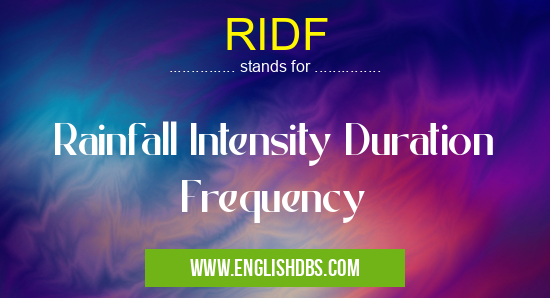What does RIDF mean in UNCLASSIFIED
RIDF (Rainfall Intensity Duration Frequency) is a commonly used metric to measure the amount and intensity of precipitation during a certain period of time. This metric is important for numerous applications, from civil engineering projects to climate change studies.

RIDF meaning in Unclassified in Miscellaneous
RIDF mostly used in an acronym Unclassified in Category Miscellaneous that means Rainfall Intensity Duration Frequency
Shorthand: RIDF,
Full Form: Rainfall Intensity Duration Frequency
For more information of "Rainfall Intensity Duration Frequency", see the section below.
What Is RIDF?
RIDF stands for rainfall intensity duration frequency, and it is a starndardized way of measuring the average amount of precipitation experienced over some given period of time. The measurements are taken by using special rain gauges that record the total rainfall as well as its intensity at regular intervals throughout that time period. For example, one hour of RIDF would measure the total rainfall between 0-1 hour, 1-2 hours, 2-3 hours etc… As such, the RIDF value will always vary based on the location within which it is measured and the particular weather conditions that are present at the time of measurement.
Benefits Of Measuring RIDF
The main benefit of measuring RIDF is that it can be used to accurately quantify average precipitation in any given area in order to make predictions about future rainfall volumes. It can also be used to help assess drainage systems and soil erosion issues in urban areas as well as agricultural development projects in rural areas. Additionally, these measurements can also be used to help inform decisions about flood prevention measures and other water management strategies.
Essential Questions and Answers on Rainfall Intensity Duration Frequency in "MISCELLANEOUS»UNFILED"
What is RIDF?
RIDF stands for Rainfall Intensity Duration Frequency. It is a type of statistical analysis used to evaluate the amount, duration, and frequency of rainfall in a particular area over an extended period of time.
How does RIDF work?
RIDF works by examining various rain events that take place in an area over a certain period of time and predicting the likelihood of similar events occurring in the future. This helps meteorologists better forecast future weather patterns and climate models.
What type of data does RIDF rely on?
RIDF relies upon the historical records of rainfall for an area. This data can include information about the intensity, duration, and frequency of storms or other precipitation events such as hail, sleet, snow, etc.
How is RIDF useful?
RIDFS are useful for predicting potential flooding, forecasting severe weather alerts from thunderstorms or hurricanes more accurately, and helping determine which areas may require extra water resources during dry spells. It also provides a means to study past weather patterns so we can better prepare for coming climate changes.
What are typical units of measure used when evaluating rainfall through RIDF?
Typical units used when evaluating rainfall through RIDF include inches per hour (in/hr), centimeters per second (cm/s), millimeters per day (mm/day), liters per square meter (L/m2) and other units commonly used to measure precipitation amounts.
Does RIDF consider only direct measures of rainfall?
While most evaluations done using RIDF will be based solely on direct measures of rainfall such as rain gauges or satellite readings, some models may incorporate other variables such as wind speed or barometric pressure into their calculations.
How often should one perform an analysis using RIDF?
The frequency with which one performs an analysis using RIDF depends largely on the needs and goals of your project; however it should typically be done at least once every year to ensure you have up-to-date data about regional weather conditions.
Are there any drawbacks associated with utilizing data collected through the use of RIDFs?
One potential drawback to utilizing data collected with this method lies in its reliance on historical records; while these records provide good basis for comparison they do not necessarily provide predictive accuracy due to rapidly changing climatic conditions.
Is it possible to obtain more accurate results from analyses conducted through the use ofR IDFs?
Yes! Advanced forms of this analysis have been developed that allow for more precise predictions by incorporating additional variables such as soil moisture levels,latitude/longitude coordinates,and vegetation cover into their calculations.
Final Words:
As you can see, Rainfall Intensity Duration Frequency (RIDF) is an invaluable tool for measuring average precipitation over a certain period of
